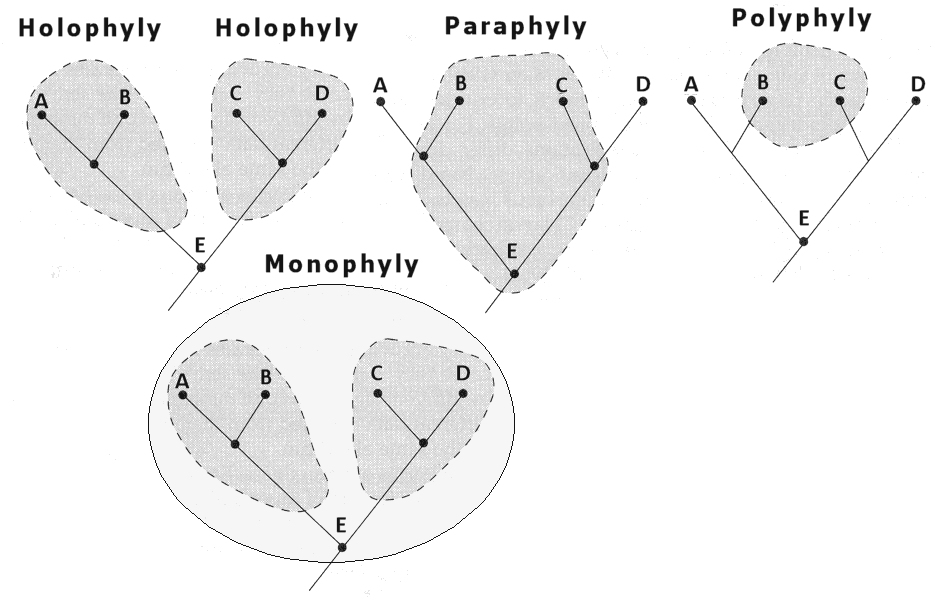
Variations on Monophyly: Holophyly, Paraphyly, & Polyphyly
Loosely, a "monophyletic"
group is any group that has a common ancestor. Thus a
taxon that comprises A B C D and their common
ancestor E is monophyletic sensu lato. ("in the
broad sense"). However, because all living organisms
have a common ancestor, any conceivable grouping of organisms
would qualify as "monophyletic". We can recognize three
types of monophyletic taxa, only one of which is "monophyletic"
sensu stricto ("in the strict sense") and serves as the basis
of modern phylogenetic taxonomy. This is the Holophyletic
group, which includes a common ancestor and all of
its descendants. In the example, AB and CD are
each holophyletic, because each has a common ancestor that
is included in the group in gray. The group including [
((AB) + (CD)) + E ] is also
holophyletic, because it includes E and all of its
descendants A B C D. Holophyletic taxa are the only
ones accepted in modern phylogenetic taxonomy.
A second type of group formerly called 'monophyletic'
is now called 'Paraphyletic.' A paraphyletic group
includes a common ancestor and some but not all of its
descendants. In the example, the group B C E has a
common ancestor E, but excludes A and D.
Such groups were formerly considered useful, for example to
indicate a judgement that B & C were
considered similar to each other, and also to E,
whereas A and D were each considered
distinctive in their own ways. Groups like B C E have
been called Grades, to indicate a similar level of
structure. For example, Reptilia, Aves, and Mammalia were
classically recognized as three separate taxonomic Classes,
marked by scales, feathers, and hair, respectively. With the
modern recognition that feathers and hair are both modified
scale structures, that birds are closely related to
Saurischian dinosaurs, and that mammals are descended from
Therapsid reptiles (which are not 'dinosaurs'), the concept of
'Reptilia' as a monophyletic group disappears.
Paraphyletic groups are the basis of classical taxonomy, for
example the "Seven Classes of Vertebrates". Since the 1960s,
the classical system has been replaced by the phylogenetic
system, although it persists in popular thinking and some
older textbooks.
Finally, a Polyphyletic group has
a common ancestor outside the group, but which was
regarded as useful as indicating a grade of structure, or was
at one time thought to be monophyletic. Polyphyletic groups
are excluded from modern systematics. There are many examples.
Linnaeus, the Father of Taxonomy, placed Birds and Bats in the
same group as flying creatures, though he did correctly group
whales with other mammals. Eared and Earless seals (Otarridae
and Phocidae) were at one time believed to be
descended from bear- and
weasel-like carnivores, respectively, but were
placed in the same group Pinnipedia as having similar
structure. These two families along with Walruses (Odobenidae)
are now recognized as a holophyletic group.
Figures & Text material © 2025 by Steven M. Carr